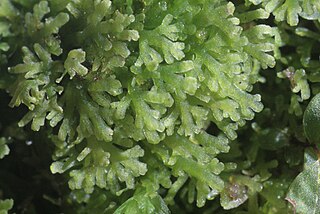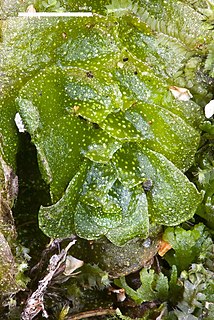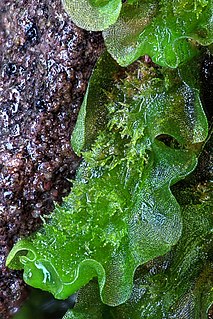Related Research Articles

The Marchantiophyta are a division of non-vascular land plants commonly referred to as hepatics or liverworts. Like mosses and hornworts, they have a gametophyte-dominant life cycle, in which cells of the plant carry only a single set of genetic information.

Marchantiales is an order of thallose liverworts that includes species like Marchantia polymorpha, a widespread plant often found beside rivers, and Lunularia cruciata, a common and often troublesome weed in moist, temperate gardens and greenhouses.

Marchantiopsida is one of three classes within the liverwort phylum Marchantiophyta.

Metzgeriales is an order of liverworts. The group is sometimes called the simple thalloid liverworts: "thalloid" because the members lack structures resembling stems or leaves, and "simple" because their tissues are thin and relatively undifferentiated. All species in the order have a small gametophyte stage and a smaller, relatively short-lived, spore-bearing stage. Although these plants are almost entirely restricted to regions with high humidity or readily available moisture, the group as a whole is widely distributed, and occurs on every continent except Antarctica.

Jungermanniopsida is the largest of three classes within the division Marchantiophyta (liverworts).

Cavicularia densa is the only species in the liverwort genus Cavicularia. The species was first described in 1897 by Franz Stephani, and is endemic to Japan, where it grows on fine moist soil.

Blasiaceae is a family of liverworts with only two species: Blasia pusilla and Cavicularia densa. The family has traditionally been classified among the Metzgeriales, but molecular cladistics suggests a placement at the base of the Marchantiopsida.

Treubiaceae is a family of liverworts in the order Treubiales. Species are large and leafy, and were previously classified among the Metzgeriales.
Sewardiella is a genus of liverwort in the family Petalophyllaceae. It contains the single species, Sewardiella tuberifera, which is endemic to India. Its natural habitat is rocky areas, and it is threatened by habitat loss.

Haplomitriopsida is a newly recognized class of liverworts comprising fifteen species in three genera. Recent cladistic analyses of nuclear, mitochondrial, and plastid gene sequences place this monophyletic group as the basal sister group to all other liverworts. The group thus provides a unique insight into the early evolution of liverworts in particular and of land plants in general.

Blasiales is an order of liverworts with a single living family and two species. The order has traditionally been classified among the Metzgeriales, but molecular cladistics suggests a placement at the base of the Marchantiopsida.
Makinoa crispata is the only species of liverwort in the genus Makinoa and family Makinoaceae. The genus Verdoornia was formerly included in this family, but has been transferred to the family Aneuraceae on the basis of recent cladistic analysis of genetic sequences.

Ptilidium is a genus of liverwort, and is the only genus in family Ptilidiaceae. It includes only three species: Ptilidium californicum, Ptilidium ciliare, and Ptilidium pulcherrimum. The genus is distributed throughout the arctic and subarctic, with disjunct populations in New Zealand and Tierra del Fuego. Molecular analysis suggests that the genus has few close relatives and diverged from other leafy liverworts early in their evolution.
Neotrichocoleaceae is a family of liverworts in order Jungermanniales. It is closely related to the genera Ptilidium and Herzogianthus.
Petalophyllaceae is a family of liverworts in the order Fossombroniales. Most species are thallose; that is, the plant is not differentiated into root, stem, and leaf. The thallus is typically small and bears lamellae on its dorsal surface that give it a ruffled, leafy appearance.

Moerckiaceae is a family of liverworts in the order Pallaviciniales. The plants are thallose, typically organized as a thick central costa (midvein), each side with a broad wing of tissue one cell in thickness. All species are dioicous.

Riella is the only genus in the liverwort family Riellaceae, and includes about eighteen species. Plants in the genus are small and grow submerged in shallow temporary pools. Although the genus is widely distributed in the Northern Hemisphere, locating populations is often difficult. Its occurrence is sporadic and local, and the tiny plants are ephemeral. The ornamented spores remain viable for several years, allowing the plants to survive annual drying of their habitat. The plants are easily grown in laboratory cultures.
Petalophyllum ralfsii, the petalwort, is a liverwort of the order Fossombroniales. It is a small green bryophyte that occurs in the Mediterranean region as far east as Turkey, and along the Atlantic coast of Europe as far as northwest Scotland. It grows primarily on moist sand dunes.
Petalophyllum, or petalwort, is a genus of liverworts in the order Fossombroniales.

Ricciocarpos natans is the only species in the genus Ricciocarpos, a genus of liverworts in the family Ricciaceae. It was formerly listed in 1759 as a species of Riccia by Linnaeus, but then assigned to a new genus of its own in 1829 by August Carl Joseph Corda.
References
- 1 2 Ford, C.H. and Crandall-Stotler, B.J. 2002. Contributions toward a monograph of Petalophyllum (Marchantiophyta). Novon, vol. 12, p. 334-337.
- ↑ Crandall-Stotler, B.J., Stotler, R.E., and Long, D.G. 2009. Phylogeny and classification of the Marchantiophyta. Edinburgh Journal of Botany, vol. 66, no. 1, p. 155-198.
- ↑ Evans, A.W. 1919. Notes on North American Hepaticae - VIII. Bryologist, vol. 22, p. 54-73.
- ↑ Crandall-Stotler, B.J. 2017. "Bryophyte Flora of North America, Provisional Publication, Petalophyllaceae". Missouri Botanical Garden . Retrieved 4 September 2017.